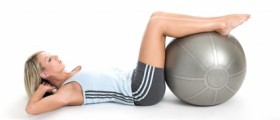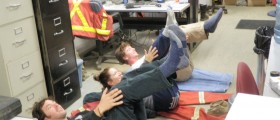
Leg cramps usually occur because of muscle spasms in calf, below and behind the knees and sometimes feet manifesting in the form of pain that lasts for about ten minutes. Severity of pain varies, but the muscle can be tender for 24 hours after cramp. Cramps usually occur during sleep when the muscles are relaxed, disturbing dream.
In most cases the true cause of cramping is not known. It is suspected that spasm occurs if the muscle which is already in a shortened position is stimulated by the contraction. This statement explains that why muscles are usually cramping at night. The position with slightly bent knees and feet pointing slightly downwards in which people usually sleep, shortens the muscle, causing cramps. However, there are other reasons leg cramps, which includes: the use of certain drugs (diuretics, nifedipine, salbutamol, terbutaline, clofibrate, penicillamine, and nicotinic acid.) excess or deficiency of calcium and sodium in the blood; dehydration, muscle overload; advanced pregnancy, a consequence of kidney dialysis, leg artery stenosis, excessive use of alcohol.The simplest, fastest and most effective method for eliminating cramps in legs is massaging and stretching the affected areas. However, pills are not a good solution because they need time to react. Though, paracetamol can be used to eliminate the muscle tension, lasting for 24 hours after the spasm.
Prevention of leg cramps primarily involves the exclusion of secondary causes (drugs and various chronic diseases) of cramps.Although the effects of stretching exercises are not enough scientifically tested, they are in most cases recommended by doctors who believe that these exercises can help prevent leg cramps. Initially these exercises should be done up to 3 times a day for 5 minutes. When leg cramps are relieved, they decrease to twice a day. It is required to exercise a minimum of 2 weeks to notice the first results. By stretching exercises cramps can be completely removed or less frequent.Some experts believe that the position of the legs during sleep may also be of great help in preventing leg cramps. If sleeping on back foot should be lift up by pillow. If sleeping on the stomach it is necessary to hang the foot at the edge of the bed. Also, the blanket should be loose around the feet to avoid turning them down.
The last option in the elimination of cramps is quinine, which carries certain risks. It usually takes one tablet of quinine before going to sleep. Pregnant women and people with certain diseases (haemolytic anemia, optic neuritis, glucose 6-phosphate dehydrogenase deficiency) should not use this drug.
Given that quinine is used in small doses for the treatment of leg cramps, side effects are rare, though serious health complications still can occur. One of them is a blood disorder that can be lethal. Also, long term use of quinine can lead to a situation that involves a combination of nausea, vomiting, dizziness and audio-visual disturbances. Quinine overdose can be extremely dangerous especially for children and therefore it should be kept away from them.
Quinine should not be used longer than 4 weeks continuously. It is advisable to keep a diary of cramps before and during quinine treatment to determine how much it is actually useful. Between the two therapies there should be a break of 3 months because it may happen that the cramps disappear entirely so quinine is no longer needed.
Quinine is the primary therapy in the treatment of cramps. However, if it does not work or causes side effects magnesium, diltiazem, vitamin B complex, vitamin E, naftidrofuryl, orphenadrine, and verapamil may be recommended although they haven’t shown particular efficacy.

















Your thoughts on this
Loading...